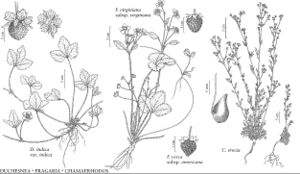Duchesnea
Trans. Linn. Soc. London 10: 372. 1811.
Herbs, perennial, ± matted, 0.5–3 dm, sparsely hairy; stoloniferous. Stems: number not recorded, prostrate or spreading to weakly erect, stolon nodes bearing single leaves or condensed shoots, consisting of paired (1–) 3-lobed green bractlets and 1+ leaves, developing into new plantlets, adventitious-roots, and peduncles. Leaves often winter-persistent, basal or cauline, alternate, ternate; stipules persistent, proximally adnate to base of petiole, sheathing, broadly lanceolate to narrowly ovate, margins entire; petiole present; blade ± cordate in outline, (1–) 2–7 cm, foliaceous, leaflets 3, elliptic to obovate, margins flat, ± doubly serrate or crenate, venation pinnate, surfaces sparsely pilose or strigose (at least abaxially). Inflorescences axillary at stolon nodes, flowers solitary; bracts absent; bracteoles absent. Pedicels present, straight. Flowers [5–] 15–20 mm diam.; epicalyx bractlets 5; hypanthium cupulate, 1–3 × 2.5–5 mm; sepals 5, spreading to erect, broadly lanceolate to ovate; petals 5, yellow, narrowly obcordate to obovate, ± equal to or shorter than sepals; stamens 20, 25, or 30, shorter than petals, filaments filiform, glabrous, thecae paired on sides of narrow connective, dehiscing by broad lateral slits; torus turbinate to hemispheric; carpels 50–100, glabrous, styles subterminal, filiform; ovule 1. Fruits accessory; aggregated achenes, 50–100 or less, borne on enlarged torus, superficial on flesh, obliquely ovoid, [8–] 10–15 (–20) mm, glabrous; torus reddish, compressed ovoid, [0.8–] 1–1.5 cm, fleshy (not pulpy), apex rounded, glabrous; hypanthium persistent; sepals persistent, spreading; styles tardily deciduous, jointed. x = 7.
Distribution
Introduced; Asia, also in South America, Europe, Africa
Discussion
Species 2 (1 in the flora).
Duchesnea is superficially similar to Fragaria in its fleshy red fruit and ternate leaves but differs in having yellow petals, doubly toothed leaflets, and protruding achenes, among other characteristics. The similarities result from convergence; phylogenetically, Duchesnea nests within Potentilla near sect. Potentilla. It is retained here as a distinct genus because of characteristics that would be anomalous in Potentilla, that is, condensed shoot structure at stolon nodes, enlarged 3-lobed epicalyx bractlets, and accessory fruit structure.
Our infrageneric taxonomy follows Li C. L. et al. (2003b), in which the stable diploid (2n = 14) Duchesnea chrysantha (Zollinger & Moritzi) Miquel is recognized as a distinct species in eastern Asia. In contrast, the most common phase of D. indica, which is the one naturalized in North America, appears to be a dodecaploid (2n = 84), although various other numbers have been reported (2n = 14, 21, 28, 49, 56), mainly from Europe. Morphological differences include achenes tuberculate in D. chrysantha versus smooth in D. indica.
Selected References
None.
Lower Taxa
"thin" is not a number.
